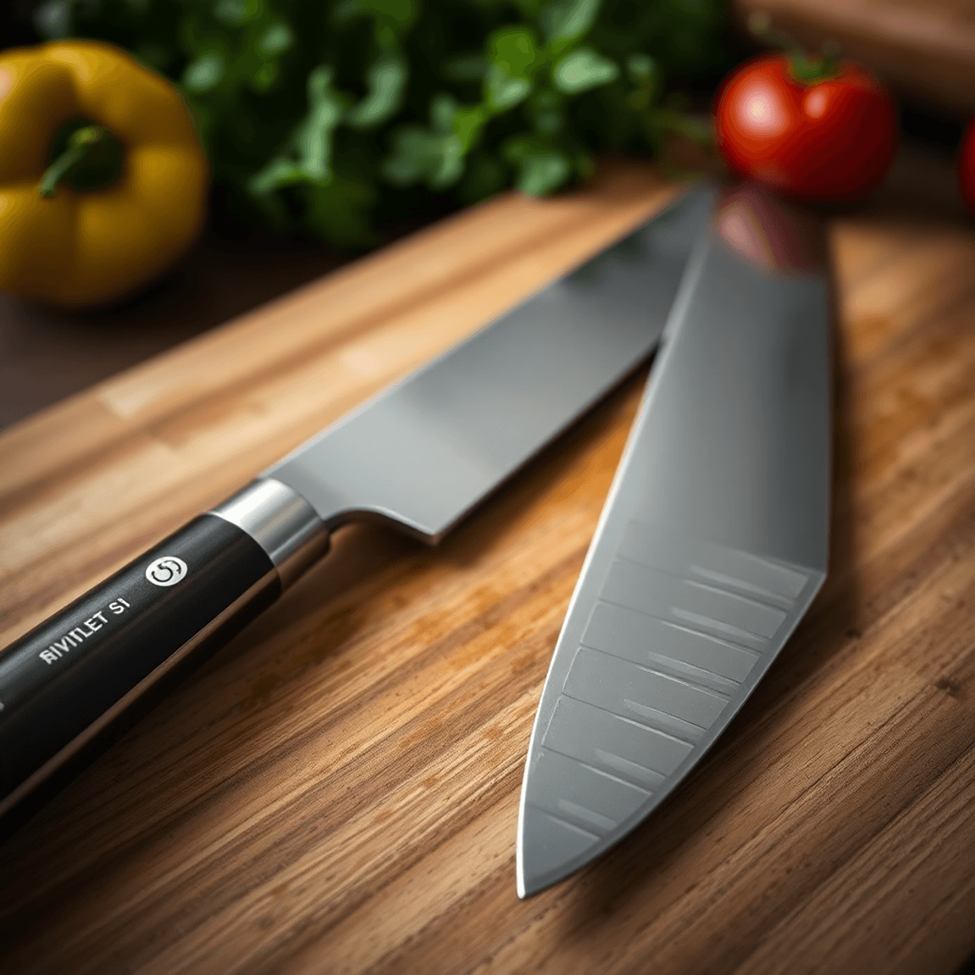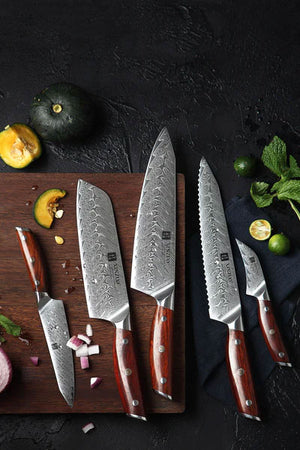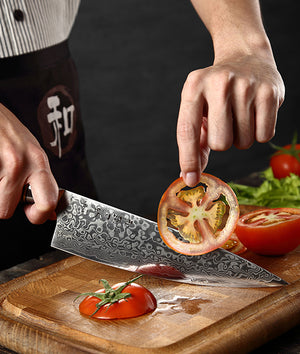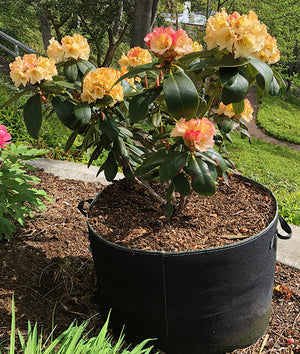
Steel Honing Rods: Why They’re a Must-Have for Every Chef
A sharp knife is essential for great cooking. Professional chefs know that keeping their knives sharp is important not just for accuracy, but also for safety, speed, and the simple pleasure of preparing food.
Many home cooks mistakenly believe their knives need frequent sharpening when they lose their edge. The truth? A steel honing rod can restore that perfect cutting ability between sharpenings. Think of sharpening as giving your knife a new edge, while honing maintains that edge through regular use.
A steel honing rod is a tool used by chefs every day to keep their knives in top shape. It works by realigning the tiny teeth on the blade that get bent during normal use. Here's what this handy tool does:
- Makes expensive kitchen knives last longer
- Keeps them cutting at their best
- Reduces the need for professional sharpening
- Ensures safer, more controlled cuts
Whether you're a professional chef or an enthusiastic home cook, a steel honing rod isn't just another kitchen gadget - it's an essential tool that transforms good knives into exceptional ones, making every slice, dice, and chop a testament to culinary craftsmanship.
However, even with a honing rod, some knives need more than just regular care. For example:
- Carving knives are versatile tools included in most knife sets, ideal for carving poultry and roasts.
- Bread knives have serrated blades specifically designed to cut through thick crusts and delicate pastries without squishing them.
In addition to these specialized knives, there are other tools that can make certain tasks easier:
Multi-functional detachable stainless food cooking shears are versatile scissors suitable for various kitchen tasks.
Paring knives with razor-sharp edges are perfect for intricate tasks like peeling or trimming fruits and vegetables.
Proper storage is also crucial for maintaining the lifespan of your knives. Using grow bags can be an innovative solution. These bags not only provide excellent storage but also help in organizing your kitchen better.
With the right tools and knowledge about knife maintenance and usage, every cook can improve their cooking skills significantly.
Understanding Steel Honing Rods
A honing rod is a long, cylindrical tool crafted specifically to maintain the edge alignment of kitchen knives. These essential kitchen implements feature a textured surface designed to realign microscopic knife edges without removing significant amounts of metal.
Common Honing Rod Materials:
- Steel - Traditional and most durable
- Ceramic - Slightly abrasive, removes small amounts of metal
- Diamond-coated - Most aggressive, acts more like a sharpening tool
- Glass - Gentle on knife edges but less durable
Steel honing rods stand out as the professional choice for several compelling reasons:
Key Benefits of Steel Honing Rods:
- Superior durability - withstands years of regular use
- Ideal hardness level - effectively realigns blade edges without damaging them
- Magnetic properties - helps remove metal particles during honing
- Cost-effective - requires minimal maintenance
- Versatile - works with most knife types
The ridged surface of steel honing rods creates micro-grooves that guide the knife's edge back into proper alignment. Premium steel rods often feature a nickel-chrome plating or specialized coating that enhances durability and prevents corrosion.
Steel Rod Varieties:
- Polished - Gentlest option, ideal for regular maintenance
- Grooved - More aggressive realignment for dulled edges
- Combination - Features both smooth and textured sections
The length of steel honing rods typically ranges from 9 to 14 inches, with professional models often featuring longer designs to accommodate larger knife blades. A proper steel rod should be at least 2 inches longer than your largest knife to ensure effective honing strokes.
When it comes to maintaining high-quality kitchen knives like the Xinzuo B37S carving knife or the Xinzuo B37S bread knife, investing in a reliable steel honing rod can significantly extend their lifespan and performance.
The Science Behind Honing
A knife's edge deteriorates during regular use - not through loss of material, but through microscopic bending of the blade's fine edge. This misalignment occurs when the knife encounters resistance during cutting tasks, causing the edge to fold or bend slightly to one side.
The Honing Process: Microscopic Realignment
- The steel rod's surface creates gentle pressure against the blade
- This pressure pushes the folded edge back into its original centered position
- No metal removal occurs during this process
- The blade maintains its existing edge angle
Understanding Edge Deformation
- Knife edges bend at a microscopic level
- The edge can fold in either direction
- Regular use causes progressive misalignment
- Visual inspection often can't detect these minor deformations
Honing vs. Sharpening: Key Differences
|
Honing |
Sharpening |
|
|
Definition |
Realigns existing edge |
Removes blade material |
|
Process |
Quick (30-60 seconds) |
Longer (5-10 minutes) |
|
Frequency |
Can be performed daily |
Every 3-6 months |
|
Edge Angle |
Maintains current edge angle |
Changes edge angle |
|
Result |
Perfectly aligned and centered blade |
New edge |
A properly honed knife edge resembles a straight razor - perfectly aligned and centered. This alignment allows the blade to cut with maximum efficiency, requiring less force and providing cleaner cuts through food. Regular honing maintains this optimal edge alignment between necessary sharpening sessions.
Benefits of Using Steel Honing Rods in the Kitchen
Regular use of steel honing rods delivers significant advantages for both professional chefs and home cooks. A well-maintained knife edge translates directly into superior kitchen performance and extended blade longevity.
Extended Knife Lifespan
- Reduces the frequency of professional sharpening sessions
- Prevents microscopic edge damage from developing into larger issues
- Maintains the original factory edge angle for longer periods
- Minimizes metal loss compared to frequent sharpening
Enhanced Cutting Performance
- Creates clean, precise cuts without crushing or tearing
- Reduces the force needed for slicing and chopping
- Enables consistent thin slices for delicate ingredients
- Prevents food from sticking to the blade during cuts
Time and Cost Efficiency
- Saves money on professional sharpening services
- Reduces prep time with consistently sharp blades
- Minimizes food waste from imprecise cuts
- Decreases the need for blade replacement
Safety Benefits
- Sharp blades require less force, reducing accident risks
- Predictable cutting behavior prevents slips
- Maintains better control during intricate cutting tasks
- Reduces hand fatigue during extended prep sessions
The daily use of steel honing rods creates a noticeable difference in kitchen efficiency. Professional chefs often hone their knives before each service, while home cooks benefit from honing sessions 2-3 times per week, depending on usage intensity.
However, maintaining kitchen tools goes beyond just honing knives. It's equally important to care for cutting boards and other wooden surfaces. For this purpose, utilizing products like Clark's Coconut Cutting Board Oil, which is formulated using 100% natural refined coconut oil that is food safe, can be incredibly beneficial. This oil is renewable, sustainable, and just plain good for our planet!
Additionally, keeping cutting boards clean is crucial. Clark's Cutting Board Soap, enriched with orange and lemon extracts, is designed specifically to kill food borne germs on wood surfaces while being free of harmful chemicals.
Finally, after applying oils or soaps, it's essential to buff the surfaces properly. Using Clark's Buffing Pads can help achieve this by providing a good buffing pad specifically designed for use with wax.
Integrating steel honing rods into your kitchen routine along with proper care of cutting boards and other wooden surfaces can significantly improve your cooking experience.
Specific Advantages for Different Knife Types and Maintenance Tips for Honing Rods and Knives
Japanese knives, such as the XINZUO B37 Japanese Damascus Steel Kitchen Chef Knife, which are often crafted from high-carbon steel or Damascus steel with hardness ratings of 60+ HRC, require special attention in their honing routine. These premium blades benefit from gentle, precise honing techniques.
Japanese Knife Honing Guidelines:
- Use lighter pressure compared to Western knives
- Maintain a consistent 15-20 degree angle
- Limit honing sessions to 2-3 strokes per side
- Consider ceramic honing rods for extremely hard steels
Knife-Specific Honing Recommendations:
Western-Style Chef's Knives
- Standard steel honing rods work well
- 20-degree angle maintenance
- 4-5 strokes per side acceptable
Santoku and Nakiri Knives
- Ceramic or fine steel honing rods recommended
- Keep 15-degree angle consistent
- Light pressure essential
Utility and Paring Knives
- Shorter honing rods preferred
- Maintain original edge angle
- Quick, light strokes sufficient
Honing Rod Maintenance:
Daily Care
- Wipe clean after each use
- Store in dry location
- Use mineral oil periodically
Deep Cleaning Protocol
- Scrub with warm soapy water
- Dry immediately and thoroughly
- Apply food-grade mineral oil
- Store vertically when possible
The proper care of honing rods ensures their effectiveness and longevity. Regular cleaning prevents metal particles and debris from affecting future honing sessions. A well-maintained honing rod paired with appropriate technique preserves the cutting edge of both Western and Japanese knives, such as the Hezhen PM8S Kitchen Chef Knife Set or the Xinzuo Deba Professional Handmade Japanese Knife, extending their performance between professional sharpening.
Using a Steel Honing Rod Effectively: Technique, Proper Usage Tips, and Knife Safety Measures
Mastering the proper honing technique ensures optimal blade maintenance and personal safety. Here's a detailed guide to help you perfect your honing skills:
Step-by-Step Honing Process:
- Secure Position: Hold the honing rod vertically against a stable surface, plant the rod's tip firmly on a non-slip cutting board, and keep your body positioned at a comfortable distance.
- Proper Angle: Position your knife at a 20-degree angle against the rod (adjust to a 15-degree angle for Japanese knives) and maintain this angle consistently throughout the process.
- Execution: Start at the heel of the blade, draw the knife downward and toward you, end at the tip of the blade, and alternate sides with each stroke.
Pressure and Stroke Guidelines:
- Apply gentle, consistent pressure equivalent to the weight of 2-3 coins
- Perform 4-5 strokes per side for regular maintenance
- Maintain steady, controlled movements rather than quick strokes
Safety Precautions:
- Keep fingers away from the rod's surface during honing
- Ensure proper lighting in your workspace
- Wear cut-resistant gloves if needed
- Never test blade sharpness with your fingers
Common Mistakes to Avoid:
- Applying excessive pressure
- Using inconsistent angles
- Rushing through the process
- Honing on an unstable surface
The effectiveness of honing depends on maintaining proper technique and consistent practice. Regular honing sessions with correct form will significantly improve your knife's performance and extend its lifespan.
For instance, when using a high-quality knife such as the Xinzuo B35 12" Granton German Steel Carving Knife, mastering these techniques becomes even more critical. This versatile knife is ideal for poultry and roasts, but achieving optimal performance requires regular honing with precision and care.
Choosing the Right Honing Rod for Your Kitchen: Features to Consider Based on Chef Preferences and Experience Levels
Selecting the perfect honing rod requires careful consideration of several key features that match your specific needs and cooking style.
Length Considerations
- 12-inch rods suit most home kitchen needs
- 10-inch options work well for smaller knife collections
- 14-inch professional-grade rods accommodate larger chef knives
Material Quality Indicators
- High-carbon steel - optimal for Western-style knives
- Chrome-plated steel - resistant to corrosion
- Diamond-coated steel - aggressive realignment for damaged edges
Surface Texture
- Smooth - ideal for regular maintenance
- Grooved - provides faster edge realignment
- Combination surfaces - versatile for different knife types
Handle Ergonomics
- Slip-resistant grip materials
- Balanced weight distribution
- Guard size for hand protection
Rod Magnetization
- Magnetized rods capture metal particles
- Non-magnetic options require more frequent cleaning
- Magnetic properties help maintain cleanliness during use
Price Range Considerations
- Entry-level: $15-30 suitable for beginners
- Mid-range: $30-60 ideal for enthusiast home chefs
- Professional: $60+ premium materials and construction
A rod's diameter should match your knife collection - standard 3/8-inch works for most kitchen knives, while specialized sizes cater to specific blade types. For high-quality honing rods and other kitchen essentials like Damascus kitchen knives, consider exploring the offerings at The Bamboo Guy, which also provides a range of cutting boards, knife holders, garden grow bags, and more.
Conclusion
A steel honing rod is an essential tool for any knife collection. It is a must-have tool that enhances your cooking experience by keeping your kitchen knives sharp and prolonging their lifespan.
Investing in a high-quality steel honing rod brings several benefits:
- Improved cutting accuracy
- Less frequent need for professional sharpening
- Extended lifespan of your knives
- Safer cooking practices
Both professional chefs and home cooks understand the importance of well-maintained knives in the cooking process. Whether it's achieving precise vegetable cuts or effortlessly preparing proteins, a properly honed blade makes every task easier and more enjoyable.
Your knives are an important investment in your culinary journey. A steel honing rod acts as a protector, ensuring they always perform at their best. Make this essential tool a part of your kitchen – it will enhance your cooking and dining experiences.



